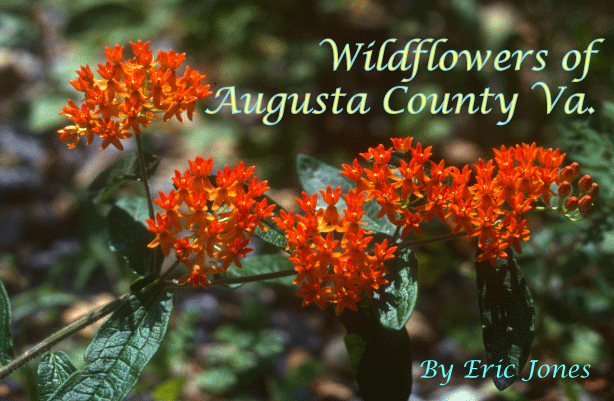 |
||
|
Augusta County is located in the Shenandoah Valley of Virginia and runs from the crest of the Blue Ridge Mountains on the east, across the Great Valley of Virginia to the crest of Shenandoah Mountain to the west. The county has over 3000 feet of change in elevation from a low point of 1080 feet as the South River leaves the County to the north, to a high of 4463 feet at Elliot Knob in the western section of the county. Combined with a wide range of bedrock and every possible slope orientation it presents a very diverse collection of habitats. The result is an ideal situation for the wildflower enthusiast. This site is an attempt to introduce you to 240 of the wildflowers of Augusta Co. VA. Use the drop down menus to navigate the site, and test your identification skills with the quiz pages. Directions for Use When you identify a flower in the field you should come back and look it up using either the Scientific Name or Common Name species lists. Look at the other members of the same family and genus using the previous and next buttons to find the similarities. Some of the joy of identifying wildflowers comes from knowing what their names mean, and how we used them in the past; this is the primary purpose for this work. This e-book is designed to supplement a good field guide, I recommend Lawrence Newcomb, 1977. Newcomb’s Wildflower Guide. Little Brown and Co. New York. Newcomb has designed a unique key that allows you to identify flowers quickly with a minimum use of terminology. When you start you will be able to find most of the flowers you see in the book. As your search widens you will begin to come across flowers that don’t quite fit the book’s descriptions. This is not an excuse to give up but a chance to realize that evolution is in action and that variation occurs. At this point in your development you will begin to move on to a more complete text. Several excellent State Floras exist I find Rhoads, Ann Fowler and Timothy A. Block 2000. The Plants of Pennsylvania. University of Pennsylvania Press, Philadelphia Pa. and Strausbaugh, P.D. and Earl L. Core, 1978. Flora of West Virginia. 2nd Ed. Seneca Books, Grantsville WV to be the most helpful. The habitats found in Augusta County are most closely matched in these adjacent states. Virginia’s State flora is not yet finished. Many of us started with Henry Gleason and Arthur Cronquist 1963. Manual of the Vascular Plants of Northeastern United States and Adjacent Canada. D. Van Nostrand Co. New York coupled with Henry Gleason 1968. The New Britton and Brown Illustrated Flora of the Northeastern United States and Adjacent Canada. Hafner Publishing Co. New York. The larger an area a manual covers the greater the number of species it will include that are not to be found in your area. Also the manuals that contain the greatest number of species for example Merritt Fernald 1950. Gray's Manual of Botany. 8th Ed. or Henry Gleason and Arthur Cronquist 1963. Manual of the Vascular Plants of Northeastern United States and Adjacent Canada are almost without illustration, and assume a command of the terminology of plant taxonomy. In addition to the species pages, which are the main focus of this work, a few supplemental sections are included.
All of the photographs were taken with either a Honeywell Pentax Spotmatic with a Macro Yashinon f=60mm lens or a Canon EOS D60 with a Canon Macro Lens EF 100mm. Slides were scanned using either a Nikon Cool Scan III or IVED scanner. Files were optimized using Adobe Creative Suite. The site was developed using Adobe GoLive. All images are my own, and higher dpi files are available. |
||